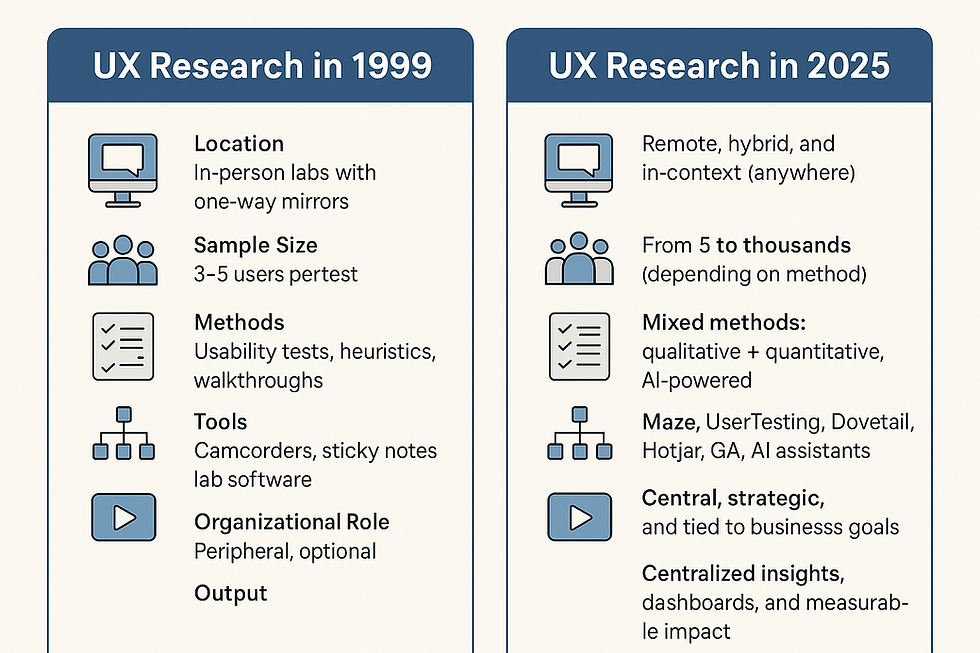Unlocking Insights with Quantitative UX Research: Tools & Best Practices
- Philip Burgess
- Aug 17
- 2 min read
Updated: Oct 26
By Philip Burgess - UX Research Leader
Quantitative UX research involves collecting numerical data that can be measured, analyzed statistically, and generalized to larger populations. The focus is on metrics, patterns, and trends—helping teams evaluate usability, identify problem areas, and validate design decisions at scale.
Examples of quantitative research in UX include:
Surveys & Polls (CSAT, NPS, SUS scores)
Task Success Rates (e.g., percentage of users who complete a checkout flow)
Time on Task (how long it takes users to complete tasks)
Clickstream Analysis (tracking paths and drop-offs)
Heatmaps & Session Replays (identifying engagement zones and friction points)
Tools for Quantitative UX Research
Several platforms stand out for supporting quantitative data collection and analysis:
1. Google Analytics & GA4
A staple for digital teams, GA tracks user behavior across websites and apps—measuring traffic, conversions, bounce rates, and custom events. It’s essential for spotting broad behavioral trends.👉 Google Analytics
2. Hotjar
Provides heatmaps, scroll maps, and session recordings that quantify where users engage most (and where they drop off). Combined with surveys, it blends both qualitative and quantitative data.👉 Hotjar

3. Maze
A remote testing platform that transforms prototype interactions into quantitative metrics—tracking time on task, success rates, and user flows automatically.👉 Maze
4. Qualtrics
An advanced survey platform ideal for running large-scale quantitative studies, including conjoint analysis, MaxDiff, and customer experience benchmarks.👉 Qualtrics
5. Optimal Workshop
Best known for quantitative card sorting and tree testing, helping teams validate information architecture with measurable results.👉 Optimal Workshop
6. FullStory / Microsoft Clarity
Analytics tools that quantify session behavior, rage clicks, scroll depth, and funnels—ideal for pinpointing where users get stuck.👉 FullStory | Microsoft Clarity
Best Practices for Quantitative UX Research
1. Define Clear Research Questions
Start with hypotheses or objectives:
“What percentage of users complete onboarding successfully?”
“Which navigation structure reduces time-on-task by 20%?”
A focused question ensures you collect the right data instead of being overwhelmed with irrelevant numbers.
2. Collect a Large Enough Sample Size
Statistical validity matters. Ensure you have enough participants to draw reliable conclusions. Tools like SurveyMonkey or Qualtrics can calculate recommended sample sizes based on your confidence levels and margin of error.
3. Combine with Qualitative Methods
Numbers tell you what is happening, but not why. Pair quantitative metrics (like drop-off rates) with qualitative methods (like user interviews) to understand root causes.
4. Measure the Right Metrics
Stick to UX-relevant KPIs:
Task success rate
Error rate
Time on task
Net Promoter Score (NPS)
System Usability Scale (SUS)Avoid vanity metrics that don’t connect back to user experience improvements.
5. Use Benchmarking
Track baseline numbers before a redesign, then measure again afterward. Quantitative research shines in showing measurable improvements (or regressions) over time.
6. Ensure Data Quality
Bias creeps in easily with poor survey design, ambiguous questions, or misconfigured analytics. Always pilot test your instruments before launching them broadly.
Final Thoughts
Quantitative UX research provides the evidence-backed numbers to support design decisions, demonstrate ROI, and drive user-centered improvements. By pairing it with qualitative methods, you gain the rich insights needed to design experiences that are both measurable and meaningful.
Investing in the right tools—from Google Analytics to Hotjar, Maze, Qualtrics, and Optimal Workshop—and following best practices ensures your data isn’t just numbers, but actionable insights.
Philip Burgess | philipburgess.net | phil@philipburgess.net




Comments